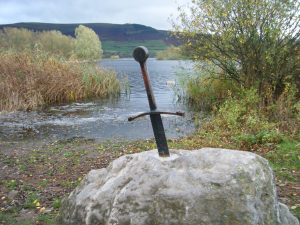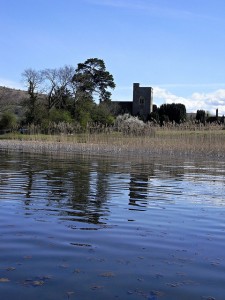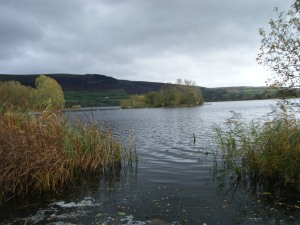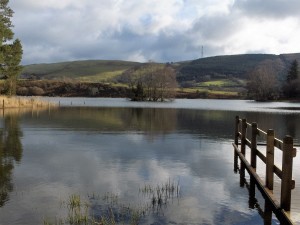How nice is this !? I get up when I want, I stay up as long as I want, I do what I want, I walk out where and when I want. Apparently it’s called ‘retirement’, and I am finally beginning to understand what it entails !
A few weeks have now past without me having to attend to any walling work. There is an outstanding job awaiting my attention and sooner now rather than later, I’m going to have to get on it; it needs to be completed by the end of the year which really means before Christmas. That has been somewhat fortuitous given the state of play, wind and rain has been incessant, thus it has been a grateful Welshwaller who has either stayed indoors or gone and satiated other needs.
It is actually coincidental that much of my ‘wandering’ has involved water; inland water which holds various memories and fascinations.
My first sojourn took me to a place I visit fairly often, or used to. This year I seem to have had very few encounters with the quiet waters of Llangorse Lake in the south of the old county of Breconshire.
It is both historic in my life and in the story of man in that part of Wales. I have often recounted in this blog, my visits to the old Elizabethan manor house of Ty Mawr, the home of my friends at Ty Mawr lime. (As I wrote back in August, the lady of the house, Joyce, is, as I write, following in the footsteps of the first Welsh settlers to Patagonia) There is history all around the shores of the lake, much of it, I’m certain, still to be discovered and interpreted.
For example, the very name throws up some questions in my mind as to the accuracy of much of the perceived wisdom of historical origins. History records the lake under the name ‘Brecenanmere’ which is to say ‘the sea of Brecon’. In Welsh it is known as Llyn Syfaddyn’ and it is that name with which it was known throughout much of the medieval period. In fact it was not until the nineteenth century that the name Llangorse came into common parlance. It bears some examination as an eponymous title. The nearby village of that name is not really that historic, it was in fact a Norman ‘planted’ village, which is to say it was an example of town planning commonly employed by the French overlords once they had subdued the locals in about 1067. Instead of the scattered farmsteads of the natives, the ‘Welshry’, with their associated dispersed field strips or ‘Rhandirs’ and the inherent inefficiencies of agricultural production, the Normans simply rebuilt the farms in a cluster around a church, a pond, a smithy and an ale house, of course. The village core usually had a cross roads (and was thus often built at a strategic confluence of routes or rivers, fords and defensive sites). Llangorse village is an excellent example of such planted villages (as are the nearby villages of Llanwern, Llanfihangel Talyllyn and Llanfilo) with its five farms, church, pubs and ‘burgages’, the shops of their day. But it is the name which is interesting; the Llan is often associated with the extant church, generally an original Norman (or a few centuries later) but the term actually refers to the enclosure in which the church is sited. Llan sites can often be much earlier constructions and are often thought to be the sites of very early Christian monastic cells. The second element of the name is often the name of the Saint (usually an early Celtic Saint) but can sometimes be a reference to the geography in which it is placed. Such is the case with Llangorse; the prefix is clear but the second element is a mutated form of the word ‘Cors’ which is generally taken to mean a very boggy or wet parcel of land (as in Cors Caron, the 8 mile long bog at the head of the river Teifi in Cardiganshire). Therein lies my question; the village to which that name is appended is not at all in a wet place, far from it, the farmland which surrounds the planted village is excellent well draining sandstone soil of proven fertility. Most academics presume the name of the village is taken from the name of the nearby lake but that must be erroneous as the lake was not known by that name at the time the village was created.
The lake has a characteristic shape and on the ‘inside’ curve where the brown rush can be seen in this photograph, lies the church of Llangasty.
There is however, a church which does sit in a boggy place and what’s more, it sits right on the shore of the lake; indeed it is surrounded by the lake at times of high water. That church bears the name of a little recorded Celtic Saint, Castyn (in fact it is the only site which bears his name). The little Llangasty church sits amongst the rushes on the western shore of the lake. To my thinking IT is the ‘llan cors’ which historic documents record.
Now in one sense it is no matter, after all, time has determined that the village of Llangorse is deemed to be named after the lake and that somehow the Welsh description must apply to the church in the village. So much so that many archaeological explorations and digs, including the famous Time Team and the ‘not-so-famous’ experts from the National Museum of Wales and Oxford University, have spent hundreds of hours and pounds searching for lost buildings and ‘finds’.
Much of that searching has been for the site of an abbey, a mention of which occurs in the C6th Charter granting a large amount of land to the Bishop of ‘Llancors’. The six thousand or so acres of land was enclosed by a large earth bank some of which I have been able to locate on the slopes above the village (close-by is the farm Cwrt y Prior). The assumption has always been, reinforced by a suspicion (for it is no more than that in reality) that the llan of the church in the village is of a mainly circular form (suggesting possible early, if not pre Christian, occupation), and that the abbey is in that locality. Indeed a circular field on the nearby common, which itself joins the lake shore, has also been much investigated. Surprise, surprise, they haven’t yet found anything.
The site to my mind, is more likely to be on the western side of the lake, somewhere near Castyn’s little monastic cell or Clas. In fact there are massive foundations in the field adjacent to the manor of Ty Mawr, a few hundred yards from Llangasty, which, to my in-experienced eye, should be investigated. The stone-work seems far too immense in size and construction to have been merely the foundation of the Elizabethan manor for which they are presumed to have been built.
Then there is the Crannog issue. Much excitement and thousands of hours of interpretation (thinking and writing) has been expended on the little island which sits some thirty metres from the east shore of the lake. It came back into public conscience in the middle of the C19th when a lowering of the lake water level saw it emerge from the dark water. At the same time a dug-out canoe was exhumed from the muddy foreshore. The crannog is a man made island made up of various layers of hazel and stones and surrounded by oak paling driven into the lake bed. It is a common construction on the lakes of Ireland and is presumed to be a fairly early, maybe even pre Roman, type of structure. The Llangorse crannog is thought to have been the site of a ‘palace’ which King Brychan (the eponymous ruler of Brycheiniog) had built for his Irish wife. He came to Wales after the end of the Roman period, sometime in the C5th but was actually the son of an Irish king and a Welsh (not that Wales existed then !) mother. He occupied lands in the Garthmadryn domain (Trecastle area of west Breconshire) and it is there that many standing stones with the Irish ogham inscriptions were found (and now reside in the museum in Brecon). To my mind it seems a little small for a weekend condo on the lake. Finds from the site include quite valuable items such as slate rings and Persian silks, all of which have contributed to the notion of a royal palace. The little island certainly was built well, it was still there in AD916 when an Anglo Saxon crazy woman called Athelflaed (daughter of Arthur, King of Wessex) attacked it and supposedly burned the palace.
Brychan himself is supposed to have had a couple of punch-ups around the lake, most notably with a bunch of Cornish hooligans led by one King Arthur. Indeed it has been suggested the whole ‘Sword in the Stone’ malarky happened on this very lake.

Excalibur. The Sword-in-the-Stone which alludes to King Arthur being here at Llangorse Lake. It sits looking out at the crannog.
The problem with the ‘Excalibur’tale is,”which one to be believe!” (If any !) I get very confused – did ‘he’ just heave it out of the stone or did he go into the water and take it off the damsel who was holding it aloft out of the water ? The ‘Lady of the Lake’ story seems to be more of a ‘Welsh’ idea (we being slightly less sexist and machoistic …ahem) and the ‘tough guy’ ‘Arnie’ type Arthur, who just ripples the old biceps and out it pops, is more Cornish/ English. Who knows ? Who cares !? Whatever, it is a clever bit of ‘Touristic license’ and is certainly an attractive piece of public sculpture.
‘As they rode Arthur said “I have no sword”. “No force”, said Merlin, “hereby is a sword and it shall be yours, and I may”. So they rode ’til they came to a lake, the which was a fair and broad, and in the midst of the lake Arthur was ware of an arm clothed in white samite, that held a fair sword in that hand. “Lo”, said Merlin, “yonder is that sword that I spoke of”. With that they saw a damosel going upon the lake. “What damosel is that?” said Arthur. “That is the Lady of the Lake”, said Merlin.’
There is another interesting link to Llangorse and the crannog finds that often crosses my mind whilst I sit looking out at the little island. The church of Llangorse village is dedicated to St. Paulinus (unfortunately there are two of those and no-one is certain which one is which). Paulinus roamed between Brittany, Cornwall and Wales and is honoured in many churches. His life story (St. Pol de Leon) is interesting and it seems he was a Roman nobleman. But he disappears from history and the last reference tells of him going to live ‘on an island in the sea’. No-one knows where that ‘sea’ was but given that right up until his disappearance he was active in the areas of Carmarthenshire and Breconshire, given that in the centuries in which he lived the lake was known as the ‘sea of Brycheiniog’, given that the rich silks and rings found in the silts around the crannog (an island !) came from the east …. might it just be that it was the Llangorse crannog that was Paulinus’ last domain ? After all, why else should the church bear his name and surely even Brychan was not so ‘connected’ he could buy his wife expensive gifts from the orient ? But who am I to come up with such silly suggestions !?

The ‘enclosure in the bog’, the ancient site of St. Castyn on the western shore of Llangorse lake. Surely this is the llancors!
I have enjoyed the still waters of Llangorse lake since my childhood days. My uncle Bryn had a small rowing boat to which a two stroke Seagull engine was attached and once or twice each summer he would take myself and some other boys, all of whom worked Saturday jobs in the grocery/bakery shop that my grandfather, uncles, mother and aunts worked in and owned (B. Deakin & Sons of Five Locks Road, Pontnewydd), on an outing. Of course to a young boy the lake seemed enormous and it took forever for us to row or motor around it. The favourite part was when we cut the motor, just on the edge of the massively tall reed beds on the south west tip of the lake, and proceeded to punt our way into them using the wooden oars. I well remember we all felt we were following in the wake of the ‘African Queen’ (which I suppose was a ‘newly released’ film back then !) and ultimately uncle Bryn would have to get out aka Bogart, and haul us off the mud banks back out of the rushes to deeper water. The noisy speed-boats which hauled their skiers around the lake in those days were, to us, the German patrol boats, and we imagined how we would ram them and blow them from the water !
We always entered the lake on the small beach next to Llangasty church, little did I imagine that years later I would still be intrigued by that tranquil sheet of water and that small round stone enclosure. I eventually had that small boat given to me and continued to take it out on the lake, by then as a fisherman, often with my father on board. Even when I was able to drive myself to the lake I was still hauling the boat out of the reeds where I used to hide it throughout the Spring and Summer months. Fishing the lake was a sublime activity especially in the early light of dawn when the mist sat across the water. One really strange and somewhat spooky event happened on such a June morning. I rowed the boat out toward what I judged to be the middle of the lake for the mist was so thick I could not see but a few yards. The red ball of the dawn sun guided me to the east and when I adjudged I had gone far enough – deeper water was my goal for therein lay my quarry, the spiky finned Perch – I dropped the little anchor and set-to with my tackle. Quietly the little craft drifted around so that I was casting my bait on the side which faced back to the western shore and Llangasty. After an hour or so I became aware of an occasional ‘plop’ behind me, each time making me jump a little. On and on it went, probably at a half hour interval or so. As the sun rose and the mist began to burn away I began to see the tower of the little church and could at last see the da-glo tip of my little float as it bobbed in the still water. “Good morning !” I fell over backwards into the bottom of the boat such was I startled. Looking behind me I saw another fisherman, his boat but six feet from mine, in fact so close had we been casting toward each other we should certainly have hooked ourselves ! Amazingly he had rowed out from the eastern shore, a much greater distance than I had come and somehow, in the impenetrable gloom of the dawn mist, we had set anchor in such proximity ! The damnation of it was that he had been catching fish whereas I had not ! How we laughed, how our laughs turned to consternation when we realised we could have collided and both ended up in the water. In the days before safety concerns we neither of us had any buoyancy jackets,no, just thick heavy clothing and Wellington boots !
There is another sheet of still water which, although much smaller, is equally as enchanting and possibly more mysterious. In a secluded hollow off a quiet lane in the parish of Nantmel, hidden behind a block of conifers, lies Llyn Gwyn. Confusingly another lake of similar size lies just outside the mid Wales town of Rhayder but it is named Gwyn Llyn ! Now the llyn element is simply ‘lake’ but the ‘gwyn’ is a matter of some debate. It can mean variously,’white’, ‘fair’ or ‘holy’. It sometimes appears that historians use whichever meaning suits their argument but I have to say that the notion of ‘white’ is too often applied. I think in a geographical application the word may well relate to a ‘fair’ or hospitable setting, for instance facing the morning sun or in a sheltered spot. Often however, it is the ‘holy’ that can be missed. Holy that is in the sense of’ ‘spiritual’ as well as connected to some Christian place. In the case of Llyn Gwyn many have assumed it to be an association with Abbey Cwm Hir which lies to the north. As the lake holds carp it is argued it was the fish pond of the abbey. That may well be so but given the paucity of fish species normally associated with monastic ponds it is open to question. Some have suggested the ‘gwyn’ relates to the use or ownership of the lake by the ‘white’ (Cistercian) monks of the abbey. It may just as easily denote a ‘fair’ or beautiful spot for that it surely is.
What intrigues me about this secret place is it’s potential for pre-historic revelation. For one thing there is a substantial, (read ‘massive’) semi-circular earthwork which is marked on the O.S. map. It has a diameter of some 60 metres and is a good 5 metres high. On the ‘outside’ (i.e. away from the lake) there is a significant ditch which in winter is often filled with water. Whilst today the ends of the bank, which curves toward the lake, are some fifteen metres from the water’s edge, it is possible the lake was higher in the distant past. That is suggested by some ancient dry stone walls which look as if they should terminate at the water but end some metres short.
Then there is the matter of a strange little island which sits in the middle of the lake toward the northern end. There is no apparent reason for such a feature in terms of geology; the basin in which the lake sits is of a rich clay deposit of some depth with only small boulders scattered in it. As far as I have been able to ascertain no research has ever been done on either feature. The earth bank is mentioned in records, the island is not and the whole is noted as the probable fish pond of the abbey. I want to get into the water and have a look at that island, could it just be another crannog !? It would be a sensible construction in that setting and may well be co-eval with the embankment Another mystery to solve in my dotage !
My other water wanderings have taken me over the hills to the great reservoirs of mid Wales, Llyn Brianne and the Elan Valley, but I think they will have to wait for a later posting. Welshwaller needs to get out and gather fuel ‘ere the winter storms begin’ ! More like ‘ere they end’, days of torrential rain and howling winds have had me cocooned in a shed or in front of a roaring log fire but food stores and fuel stores need replenishing. Oh yes, and a festival approaches, an appropriate one given all the religious elements in this post !
Tales from 1915:
Sunday 15th November. Bad night. Shelling of lines.
16th. In Mons, full of friends. Best time of all.
17th. Went back to Company.
18th. Working party afternoon
19th. Nothing doing beside feet growling. (term for pain of trench foot)
20th. Relieved Warwicks at (?). On guard in trench.
21st. Went on mining. Making bomb store.
22nd. Mining party.
23rd. Mining party.
24th. Mining party.
25th. Mining party. (It is not known if ‘mining party’ refers to underground digging or laying of mines)
26th. Left for Acheux to proceed on leave. Had a bath and change
27th. Entrained at Acheux at 3 pm arrived at Le Havre and got on boat at 7pm. Left for England at 12 o’clock.
28th. Arrived at Southampton. Arrived Newport via London at 3 pm and got home.
29th. Visited Pontnewydd *
(*Pontnewydd is my home village and where Uncle Dick’s sisters lived)
30th. Visited Foundry (probably in Old Cwmbran where he used to work)
December 1st. Wednesday. Went to Pontypool.
2nd. Went to Newport and Risca and (?) concert at night.
3rd. Visited foundry and Pontnewydd. Stayed in at night.
4th. Left for London. 3 hours in London then boat to Boulogne from Folkestone. Stayed at camp in Boulogne at night.
Within two days Dick was back in the trenches “up to waist in water”. That was his last time at home for nearly a year and ahead lay a very awful winter in the Somme salient. It is hard to imagine what it must have been like to have to operate in the sort of weather I’m looking at out of my window on this bleak last day of November 2015. A century ago to the day, my Great Uncle and millions more in all the Armies just had to sit it out and try to survive whilst carrying on fighting and digging and working. And dying in their thousands or being terribly wounded or gassed. Would they think it had all been worth it ?


10/12/2015 at 8:40 am |
Hope that you enjoy your retirement. Angela and I certainly have. Only problem is it should happen straight after college! Would recommend a campervan and a ‘list’. We’ve used the Munros in Scotland but you could ‘do’ the hills in Wales over 2,000′ or indeed make your own based on your interests. Whatever enjoy and keep the Blog going. Best and seasonal regards. Alec and Angela.
13/12/2015 at 10:44 am |
Thanks both, good ideas indeed ! Hills will certainly feature greatly no doubt. Great to see you both the other week. Season’s greetings and safe climbing !